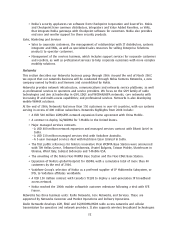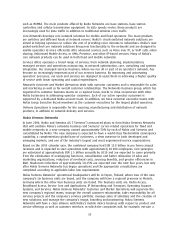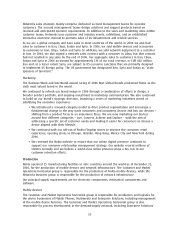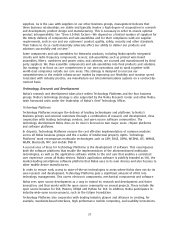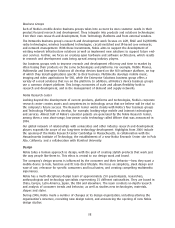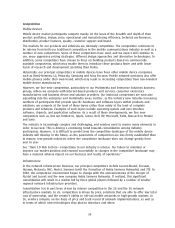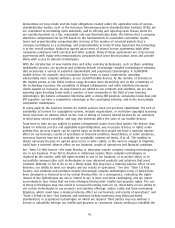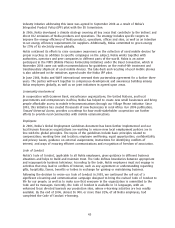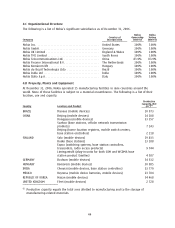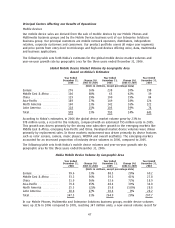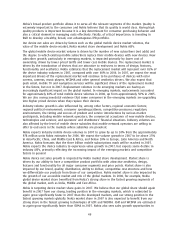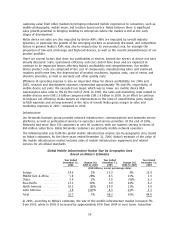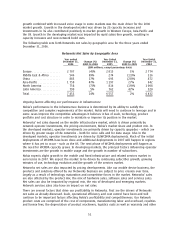Nokia 2006 Annual Report Download - page 42
Download and view the complete annual report
Please find page 42 of the 2006 Nokia annual report below. You can navigate through the pages in the report by either clicking on the pages listed below, or by using the keyword search tool below to find specific information within the annual report.declarations we have made and the legal obligations created under the applicable rules of various
standardization bodies, such as the European Telecommunication Standardization Institute (ETSI), we
are committed to promoting open standards, and to offering and agreeing upon license terms for
our essential patents on a fair, reasonable and nondiscriminatory basis. We believe that a company
should be compensated for its IPR based on the fundamentals of reasonable cumulative royalty
terms and proportionality: proportionality in terms of the number of essential patents that a
company contributes to a technology, and proportionality in terms of how important the technology
is to the overall product. Nokia has agreed upon terms of several license agreements with other
companies relating to both essential and other patents. Many of these agreements are cross license
agreements with major telecommunications companies that cover broad product areas and provide
Nokia with access to relevant technologies.
With the introduction of new mobile data and other evolving technologies, such as those enabling
multimedia services, our products and solutions include increasingly complex technological solutions
that incorporate a variety of patented standardized and proprietary technologies. A 3G/WCDMA
mobile device, for example, may incorporate three times as many components, including
substantially more complex software, as our 2G/GSM mobile devices. As the number of entrants in
the market grows, as the Nokia product range becomes more diversified, and as the complexity of
the technology increases, the possibility of alleged infringement and other intellectual property
claims against us increases. As new features are added to our products and solutions, we are also
agreeing upon licensing terms with a number of new companies in the field of new evolving
technologies. We believe companies like Nokia with a strong IPR position, cumulative knowhow and
IPR expertise can have a competitive advantage in the converging industry, and in the increasingly
competitive marketplace.
In many aspects, the business models for mobile services have not yet been established. The lack of
availability of licenses for copyrighted content, delayed negotiations, or restrictive copyright licensing
terms may have an adverse effect on the cost or timing of content related services by us, operators
or third party service providers, and may also indirectly affect the sales of our mobile devices.
From time to time we are subject to patent infringement claims from third parties. We believe that,
based on industry practice and applicable legal obligations, any necessary licenses or rights under
patents that we may require can be agreed upon on terms that would not have a material adverse
effect on our business, results of operations or financial condition. Nevertheless, in some situations,
necessary licenses may not be available on acceptable commercial terms, if at all. The inability to
obtain necessary licenses on agreed upon terms or other rights, or the need to engage in litigation,
could have a material adverse effect on our business, results of operations and financial condition.
See ‘‘Item 3.D Risk Factors—We must develop or otherwise acquire complex, evolving technologies to
use in our business. If we fail to develop or otherwise acquire these complex technologies as
required by the market, with full rights needed to use in our business, or to protect them, or to
successfully commercialize such technologies as new advanced products and solutions that meet
customer demand, or fail to do so on a timely basis, this may have a material adverse effect on our
business, our ability to meet our targets and our results of operations.’’ See also ‘‘Item 3.D Risk
Factors—Our products and solutions include increasingly complex technologies some of which have
been developed or licensed to us by certain third parties. As a consequence, evaluating the rights
related to the technologies we use or intend to use is more and more challenging, and we expect
increasingly to face claims that we have infringed third parties’ intellectual property rights. The use
of these technologies may also result in increased licensing costs for us, restrictions on our ability to
use certain technologies in our products and solution offerings, and/or costly and timeconsuming
litigation, which could have a material adverse effect on our business and results of operations’’ and
‘‘Item 3.D Risk Factors—Our products and solutions include numerous new Nokia patented,
standardized, or proprietary technologies on which we depend. Third parties may use without a
license or unlawfully infringe our intellectual property or commence actions seeking to establish the
41



